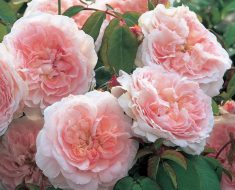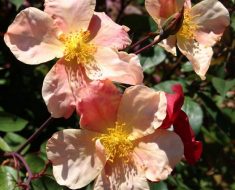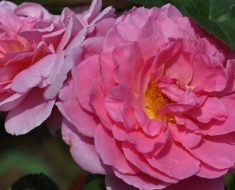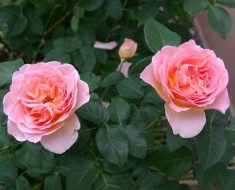English rose TROILUS got its name, like many D. Austin roses, as a result of the influence of the work of W. Shakespeare. TROILUS is one of the heroes of his play Troilus and Cressida. This rose combines the nostalgia of ancient roses and the abundance of flowering modern Austin roses. She prefers a warm climate in which she fully demonstrates her charms.
FEATURES ROSES TROILUS
- Group – English roses (English Roses)
- The basic form – a bush (shrab)
- height – up to 1,3 m
- diameter – 0.9 m
- bush shape – rounded
- Flower color – bright shades of apricot
- petals number – more than 40
- Form flower – cup-shaped rosette
- Flower size – 8-12 cm, in cold – 6-8 cm
- Flowering form – brush
- Flowering type – repeating
- Aroma – rich, strong, honey
- Foliage – dark green, dense, with shine, plentiful
- Shoots – straight, with few spikes
- Features – TROILUS rose grows well in sunny areas; thermophilic; for landing suitable southern, eastern and western directions; in cooler climates requires more attention; the second wave of flowering in cold regions is weak and the flowers lose their attractiveness during rains
- dew- medium
- resistance Black spot resistance – medium
- Mealy Cold tolerance – 6 – 9 USDA zones
- Breeder – D. Austin
- Catalog name – Ausoil
- Year of introduction to the culture – 1983
- Soil – with good drainage; rich in nutrients,
- pH – there may be slight variations from neutral (5.6 – 6.5)
- Drainage – required
- Plot – solar
- Container – yes
- Stamb – yes
- Planting types – mixed planting, hedges, container garden, rosaries, mixborders, tapeworms …
- Pests – typical of roses
- Diseases – powdery mildew, black spotting, rust of roses
CARE FOR TROILUS ROSE
PLANTING ENGLISH ROSE TROILUS
Rosa TROILUS loves sunny and protected places. The soil for it should be useful, with drainage. The landing pit for the ostrich is made so that the root system of the seedling fits freely in it. If you bought a seedling in a pot, then, as a rule, additional fertilizers at the bottom of the planting pit are not needed. If you are lucky enough to purchase an English rose seedling TROILUS with an open root system, add granular fertilizers and compost.
A grafted rose seedling is planted so that the grafting site is 3-5 cm under the soil. To maintain moisture in the soil, it can be mulched around the bush. Do not mulch only the trunk circle with a diameter of 5-10 cm. If you are planting a variety of TROILUS roses in pots, be sure to make a drainage hole and pour a layer of drainage. This is done so that moisture does not accumulate and as a result purulent diseases do not begin in the root system of the flower.
WATERING ROSES TROILUS
Roses are best watered on the soil. For the English rose, TROILUS will need one irrigation of 10 liters of warm, settled water. It is poured portionwise so that the soil has time to absorb moisture. They also use spraying of rose bushes, but do this only after the heat subsides. Mostly for the “shower” are suitable evening hours.
TROILUS roses that grow in pots are watered more often.
FEEDING FOR ENGLISH ROSE TROILUS
Without dressing, no plant will thrive. Rose TROILUS begin to feed along with the launch of the kidneys. The first feeding should contain more nitrogen. It helps to build green mass of the plant. Further, potash and phosphorus fertilizers are used, which positively affect the formation of buds. Your climate will help you determine the start and end times of feeding. On average, roses are fed 3-4 times a year.
Austin TROILUS, which grows in a pot, is fed in smaller doses than the same, but growing in open ground. But, twice as often. Combine one of the irrigations with top dressing. Give your roses vitamins. The lack of fertilizer in the life of the Queen of the Garden leads to pests and diseases. With pests and diseases on the rose, they fight with drugs available in the region.
ROSE CUTTING TROILUS
In the first year after planting, the English TROILUS rose is pruned in the fall, shortening one third of each shoot. During flowering, faded flowers are cut. Remember one rule of pruning any plant – the extreme bud must be external. This is done so that the bush is well ventilated, and pests could not quickly occupy the plant.
After wintering, TROILUS roses are cut off when they are found damaged and diseased shoots to healthy tissue, and the old main shoots are cut out completely. Use only a sharp and clean tool. For disinfection at home, use medical alcohol. It is better if the blades of the pruning shears, or any other tool for trimming, lie in it for a minute or two.
Good luck growing you!








